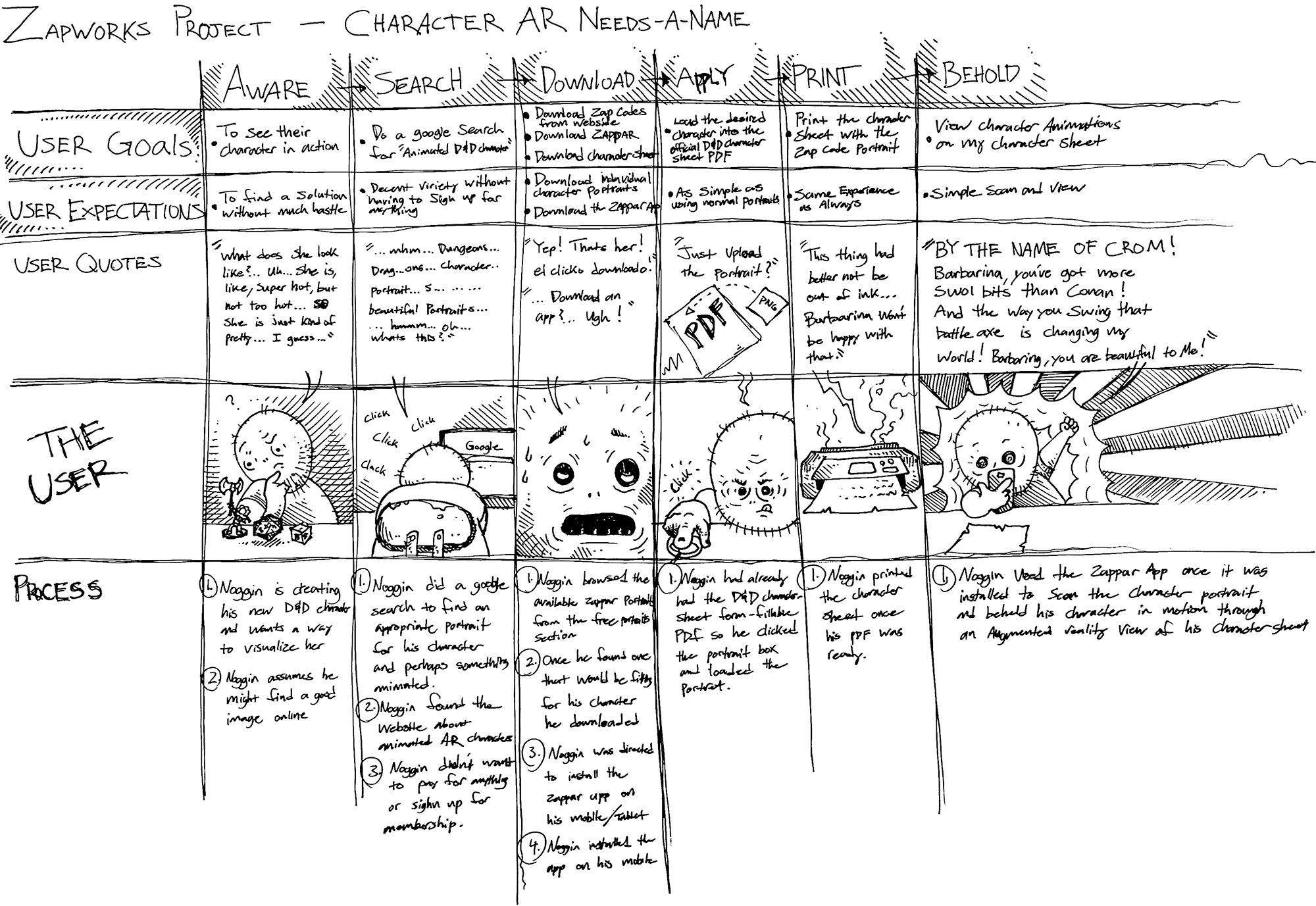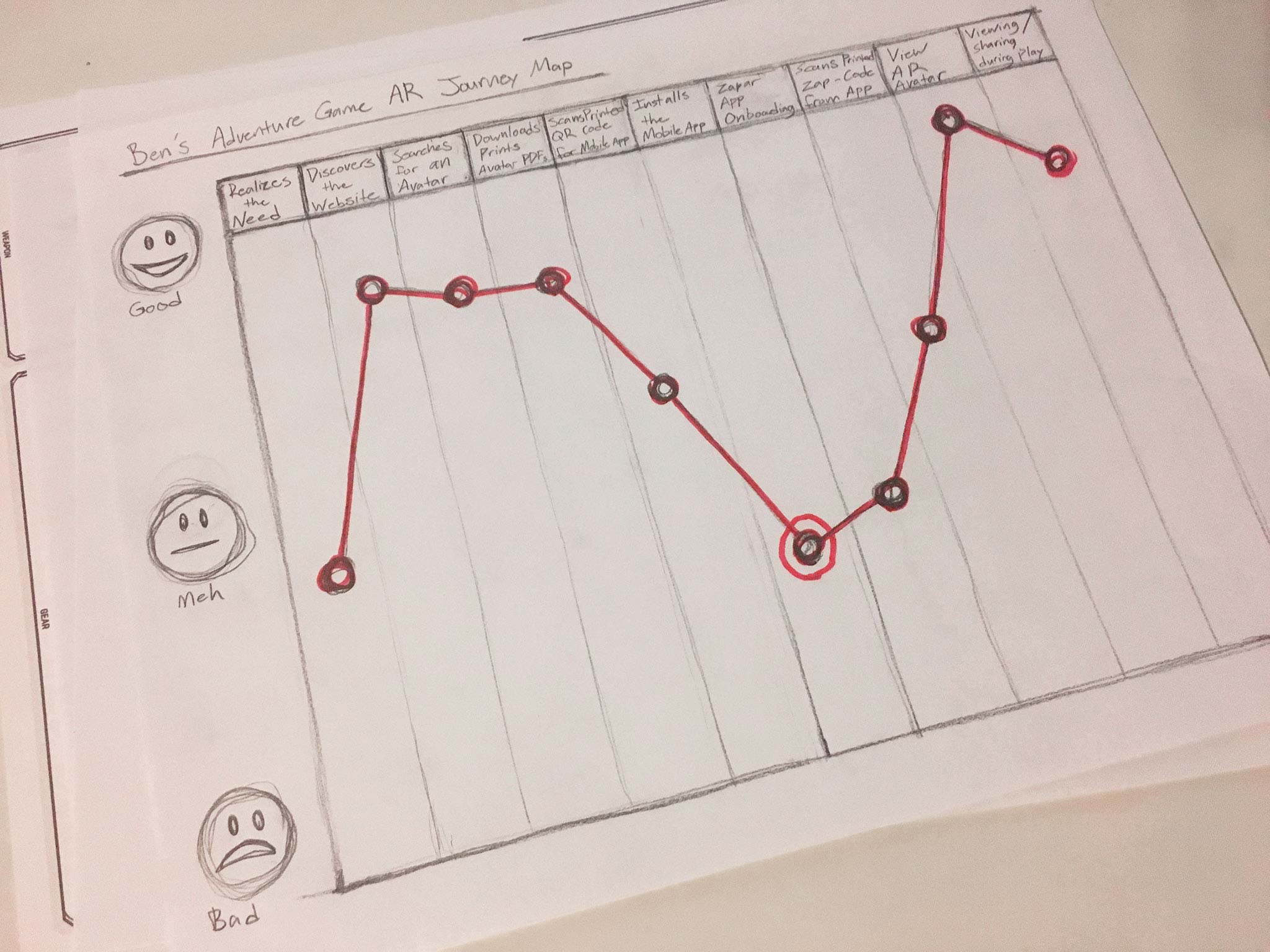
Tabletop Mixed Reality
The Goal
Bring an Augmented or Mixed Reality experience to table-top adventure gaming.
The Problem
Tabletop game players are frequently seeking ways to visualize and share their worlds and characters but their options to do so are minimal.
The Solution
Design a mixed reality experience that would utilize smartphones / tablets, and printed materials.

My Role
- Defining Acceptance Criteria
- Project Timeline Planning
- AR Tool Research
- Tabletop Gaming Research
- Tabletop Demographic Research
- 3D Asset Planning and Creation
- User Testing Planning and Execution
Stakeholder Goals
- Identify a Market
- Evaluate Feasibility
- 3D Asset Planning and Creation
- User Testing Planning and Execution
Constraints
- Hardware limitations prevent seamless integration into the tabletop game environment.
- An anti-mobile-device sentiment at many tables.
- At least four channels (website, app store, print, mobile app) before using the product.
Why Mixed Reality?
- Players commonly share visual materials via smartphones, tablets, or laptops.
- Tabletop adventure games are more mainstream than anticipated.
- In 2019, Critical Role, a Dungeons & Dragons youtube channel, contained 200 live-streamed videos with over a million views each.
- In 2018, Kickstarter, a crowdfunding platform, had raised $165 million towards tabletop games.
- The player-base is accepting of current and new technologies and a significant portion of them had crossed over from the video game markets.

The Tools
- ZapWorks Studio, a platform for creating mixed reality experiences between printed materials and digital devices.
- Autodesk Maya for creating and animating 3D models, and Adobe Photoshop for the textures.
Audience
- People who play tabletop adventure games, such as Dungeons & Dragons, Pathfinder, or Warhammer.
- 81% of the market is male, 19% is female, and more than half are older than 19.
- The majority of tabletop adventure gamers started playing around 12 years old, stopped playing through their high school years, and then picked it up again during their college ages.

Persona: Ben
Ben is a 22-year-old student who first played tabletop adventure games with his middle-school friends. They had stopped playing by the time they were in high school.
When Ben went to college, he met several people who shared fond memories of tabletop games and so they put a campaign group together, and now Ben is playing once again.
Motivations for using a mixed reality tabletop experience:
- visualizing his game characters
- visualizing the game world
- visualizing animated actions of characters and enemies
Ben's Journey Map
- He desires a way to share his character's likeness in a way that doesn't brake his suspension of disbelief during play.
- He finds the MR Avatar website which provides mixed reality experiences for tabletop adventure games.
- He browses the library of interactive character avatars on the site and finds one that is a good representation of his character.
- He downloads the PDF files for that avatar and prints them out.
- He scans a QR code to download the mobile app.
- He scans the zap code on the printed materials and ineteracts with the mixed reality avatar.
- He shares his character with the other players who then download their own character avatars.
- The Game Master downloads world-building assets for battle grids and thanks Ben for being the hero of the day.
Ben's MR Painpoints
The most severe pain-point came from the installation and onboarding of the MR app.

Zappar Functionality
- Printed artifacts contains zap-codes.
- Scanning a zap-code will launch the associated MR experience.
- The 3D MR assets will ancor to the printed artifacts.
- One limitation is that only one MR experience can be running at a time.
Prototype: Avatar
To avoid distraction at-the-table, I minimized the interactivity and kept the animations subtle. While the effect tends to impress players at first, the impracticality of interacting with something printed on a wall during gameplay became apparent. Future versions will provide the avatar anchored to a tabletop surface with similar spinning interactivity.
Prototype: Miniature
Miniatures are small figures meant to represent characters, monsters, and objects within the game world. Players use miniatures on a gameboard with a grid of 1x1 inch squares. This design has great potential, but depending on the lighting, the digital miniature can be finicky and unpredictable, sometimes rendering in strange directions or not at all.
Prototype: Battle-Grid
The battle-grid is the gameboard where the player characters battle against monsters or enemies. This deliverable had to be scaled back from the original design due to limitations with the current technology, but the physical scale of a battle-grid could potentially be enormous. For practicality purposes, I kept the grid to an 8x11.5 sheet of paper.
Testing the Protoypes
- The participants we chose usually had some experience playing tabletop adventure games. Those who had little to no experience were walked through the process of a typical game before the test began.
- Before the test we introduced them to the prototypes on a tablet and mobile device. We would run a short five minute game for the players, and during the session, we observed how and when they expected to use the prototypes.
Test Results
- Test Round 1—Inexperienced players interacted with the prototypes regularly throughout the game. Interestingly, those who had experience playing tabletop adventure games seemed more excited at first, but their interactions with the prototypes quickly dropped off as the game progressed. Several of them stopped using the prototypes the moment the game session started.
- Test Change—I felt that the test sessions were too short and weren't replicating the game environment accurately enough so for the next round of tests I took the prototypes to a dedicated group who met weekly.
- Test Round 2—This round of tests was much more valuable. Through three different sessions, I was able to get a much clearer picture of how the audience expected to use the prototypes.
- Feedback—I received repeated criticism that the devices were "getting in the way of play." I had observed that when a player tried to move the MR miniature, hey had to hold a device in one hand while moving the miniature with the other.
- Changing Expectations—I decided to remove the device from the players and they were told they wouldn't need their own device. I mounted the iPad on the table and cast the screen onto a large display beside the table where all players could view the MR content.
- Behavior Changes—With the new setup the players interacted with the game pieces on the table and viewed the MR interactions from the large screen. That small change improved the player feedback and increased the player interactions significantly.
- Prototype Limitations—At that point the most significant impediment to greater enjoyment came from the limited scope of the prototypes. The next phase of testing would require more fleshed out prototypes to gain more accurate insights.
Hurdles to Overcome
As of the time of this case study, with only a few additions to ZapWorks Studio, this product could really start to sing but for now only a single image can be trained to the content within a zap-code.
The limitations prevented features such as the battle-grid already being in play while new elements, such as player characters, monsters, and objects, are introduced into the same experience.
For this product to work, either ZapWorks Studio would need improvements to allow for the previously mentioned features, or the development of an app made specifically for this product would be required.
My Proposed Final Deliverables
- A website to hoste the PDFs for printed materials
- Onboarding videos and print for turorials and Q&A
- PDFs for character avatars, battle-grids, monsters, and objects
- Links and QR codes that take the players to the needed MR app
- An app, developed in-house or otherwise, capable of providing the desired MR experiences
- Multiple separate grids, characters, monsters, and objects to be loaded into a single experience
- In-app purchases for MR asset visual upgrades; i.e., animations, armor, and weapons
- The option to choose character temperment animations for customization
- The option to set situational mood animations; i.e., social, dungeon crawl, and combat during gameplay
The Takeaway
I came into this project knowing that the concept could be anywhere from pointless to valuable, and that a great deal of that would depend on the current technology and how I utilized it.
As it currently stands, my design is still within the product discovery phase. While my proposed final deliverables might resemble a reliable minimum viable product, a new set of tools would need to be available for generating an experience that is more aligned with the project goals.
I believe that it isn't a question of whether mixed reality is something that will become a significant part of the tabletop adventure game scene, but a question of when, and that timing will be the most crucial factor for deciding how and who will succeed.